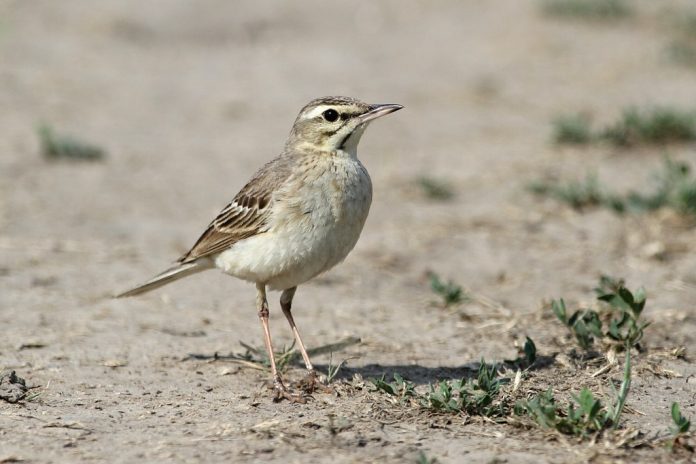Size: Tawny Pipit, “Anthus campestris” is a large bird of 17 cm in length.
Tawny Pipit vs. Richard Pipit? Tawny Pipit is a large, long-legged, and long-tailed pipit. It resembles vagrant Richard’s Pipit in size but is a little slimmer (less potbellied), with slightly shorter legs and tails, a thinner bill (with a less de-curved tip to the upper mandible), and a shorter hind claw.
The adult birds are almost unmarked (streaking very indistinctly) grayish-sandy above, with a contrasting dark median-covert bar; the underparts are pale sandy-buff with sparse and irregular dark streaking on the breast (or none). Therefore, the confusion is unlikely except with similar long-billed pipits from parts of the Middle East or with worn summer-plumaged water pipits (which, however, are less elegant-looking and have dark legs).
Dull Yellow Wagtails can look vaguely Tawny Pipit-like but have black legs. Juvenile and many autumn birds moulting into 1st-winter plumage are very different from adults. It can easily be confused with vagrant Richard’s or Blyth’s; by mid-autumn, many young birds are similar to adults. However, others have vestiges of juvenile plumage, such as uneven breast streaking or dark-centered scapulars. Others may still be mostly juvenile (heavily streaked or scalloped with dark above and below), thus resembling Richard’s.
These streaky Tawny Pipits may be distinguished from Richard’s by having a strongly streaked rump (weakly streaked in Richard’s). It often has broader pale fringes to tertials, almost uniform creamy-sandy or whitish ground color to underparts (Richard’s has warm buff flanks and to a lesser degree breast), often rather an irregular streaking on the breast (as adult feathers moult through), and, most importantly, a different head pattern.

The Tawny Pipit has a dark loral stripe (lacking in Richard’s, but note that at some angles Richard’s can seem to have dark lore, while very rarely it is faint or lacking in Tawny), narrow pale eye rings (a broader pale area about the eye in Richard’s), darker ear covers (pale-centered in Richard’s), and often a less distinct dark malar stripe. The slight structural differences mentioned above are usually apparent if the observer is familiar with both species.
In-flight, a slightly sandy or pale buff wash on the outer tail feathers is often visible when plumage is fresh, becoming whiter with wear; weaker or more chirping flight calls are also helpful; the bird often stalls briefly before alighting, typically lacking the short fluttering hover characteristic of Richard’s.
Tawny is more wagtail-like in his actions, running about with his body horizontal, often tail-wagging, although he will stand with a more erect posture; he often seems more relaxed than Richard’s Pipit. Tawny has a distinct preference for very short vegetation or bare areas (e.g., sandy tracks, short grass), whereas Richard prefers longer, coarser grassland. See also the discussions under Blyth’s and Long-billed Pipits.







